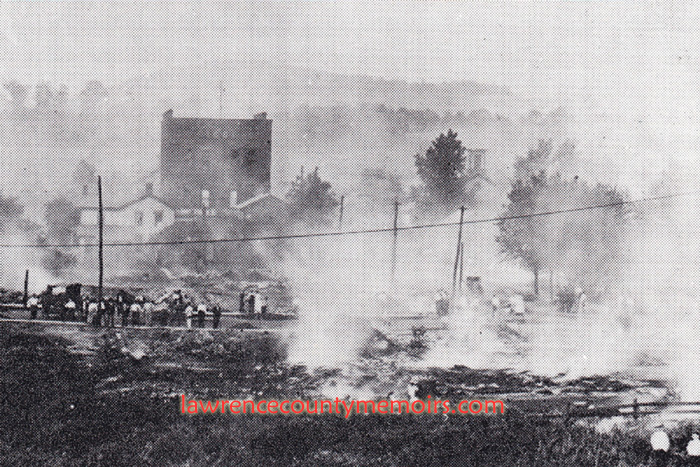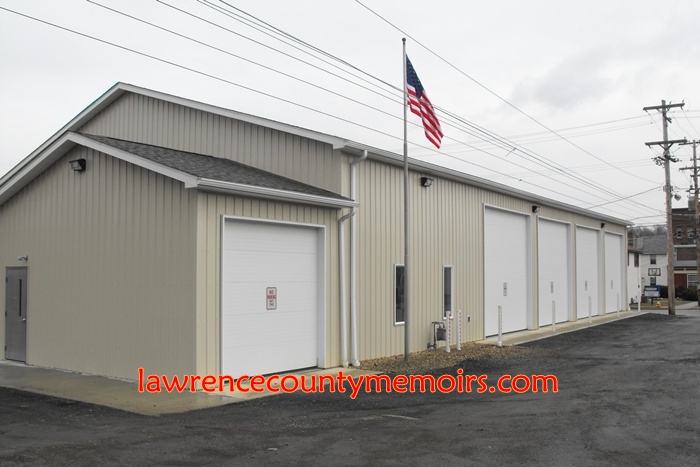The borough of Wampum in Lawrence County, Pennsylvania, reportedly organized its first volunteer firefighting company in 1890, but it could not have been anything more than a glorified bucket brigade. By the turn of the century the citizens of “downtown” Wampum, without an adequate supply of water or any firefighting equipment of their own, were living with a constant fear of raging fires. In fact the borough was well known throughout the region for the damage caused by several costly fires during the early 1900’s. However, the most significant fire – or actually fires – was poised to wreck havoc on Wampum in the summer of 1910.
The first fire broke out on the morning of Sunday, July 10, and was a raging inferno that destroyed most of the structures along Beaver Street from Church Street on up westward. Fire departments from distant Ellwood City, New Castle, and Beaver Falls responded to help subdue the blaze, but by the time they could arrive the damage had been done. Dynamite was used to help blow up and remove a few buildings to create a fire break. Six homes and a handful of businesses, including the old Yoho blacksmith shop, near the intersection of Beaver and Church streets were lost. The origin of the fire apparently resulted from little girl, in the residence of Joseph (or Jacob) Holstein, knocking over a kerosene lantern she was attempting to light. Fortunately, despite the damage, there was no loss of life.
Residents had feared the whole town would be lost and moved all of their furnishings and belongings into a nearby field, where apparently some folks from nearby Chewton and other passersby may have done some “unauthorized” shopping. Police officers soon secured the area. Businessman Frank G. Morrow and borough Council President (and former hotel proprietor and horse breeder) Charles Staph suffered damages amounting to $6,000 and $5,000 respectively and total losses to the town totaled $29,100.
As the residents of Wampum cleaned up and the borough council debated on purchasing a firefighting truck of its own, another fire struck in the same general area at 3:00am on Wednesday, July 27. It apparently started on the second floor of the John Weitz butcher shop where a group of drunken Italian men, who had been shooting off fireworks earlier in the evening, were sleeping. It quickly spread out of control and destroyed about eleven homes and businesses along Beaver Street, from Church Street towards Railroad Street. Firefighters from New Castle, Ellwood City, and Beaver Falls once again responded to help stop the destruction of the entire town. Among the businesses lost were C. C. Cunningham’s general store, John Weitz’ butcher shop, and a furniture store associated with the McKim Brothers of Ellwood City, in addition to property belonging to John Dindinger, Jerry Purcell, and George Craven.
Beaver Street had been the center of the business district and was the longtime home to many local factories, shops, and stores. In the months and years after the July 1910 fires a building boom saw mostly houses rebuilt along Beaver Street, while the majority of the businesses relocated over to Main Street. In February 1912, looking to finally put the fear of fire to rest, the borough stood up an electric-powered water works plant and began talks to form a well-equipped volunteer fire department of its own.
In December 1904 my 44-year-old great great grandfather Joseph Doutt, who served in the elected office of “Inspector” in Wampum, started a small fire along Beaver Street that caused quite a scare. The following article, albeit a bit of a humorous read, reveals the seriousness of the fire threat in Wampum. To read the article click on: 1904 FIRE SCARE ARTICLE. Among those who suffered some losses in the big Wampum fire was undertaker David Marshall. To read about his loss click on: MARSHALL SUFFERS LOSS ARTICLE. To read about how the Wampum Council took up the long-standing issue of purchasing an auto fire truck click on: FIRE TRUCK ARTICLE. To read about the scarcity of horse-drawn carriages (rigs) in New Castle during the fire and how the borough of Hazel Dell (north Ellwood City) became concerned about suffering from just such a fire of its own click on: RIGS SHORTAGE ARTICLE and HAZEL DELL REACTS ARTICLE. To read two short articles from late 1910 about the rebuilding effort in Wampum click on: WAMPUM RISES FROM ASHES ARTICLE and BUILDING BOOM ARTICLE. To read about how the longstanding fire threat in Wampum was basically ended when a new water works plant that was finally stood up click on: 1912 WATER PLANT ARTICLE.
 Wampum residents gather on a street corner to view the damage along Beaver Street. |
 Smokes rises from the ashes along the intersection of Beaver and Church Streets. The opera house/IOOF lodge is visible in the background. |
 Many businesses along Beaver Street were burned to the ground during the fires of July 10 and 17, 1910. Full Size |
 |
 A Pennsylvania Railroad (PRR) train stops at the station on the low grade, just above the destruction of Beaver Street in July 1910. |
 The back of this unmailed postcard has a handwritten note that reads, ’11 building (sic) destroyed July 27, 1910 Wampum, PA.’ |
 George Herbert and Herman “Slim” Ison stand duty at the old Wampum Municipal Building/Fire Dept. (c1960) |  An early ambulance/EMT wagon belonging to the Wampum borough. (c1960) |
 Longtime President of the Wampum Volunteer Fire Department Alfred “Dusty” Esoldo, Fire Chief Herman “Slim” Ison, and volunteer fireman Ralph L. Barber (1907-1984) standing beside an old fire wagon. Barber lived with his wife Mildred in an apartment above the fire station for many years. (c1960) Full Size |
 The same antique fire wagon from the previously photo still looking good to this day. (Jul 2009) |  A closeup of the door of the antique fire truck. (Jul 2009) |
 The new fire station in Wampum at the intersection of Church & Beaver Streets. (Jan 2012) Full Size |
 The new home of the Wampum Volunteer Fire Department. (Mar 2013) Full Size |









Comments
Camelia Stelter #
Hello Jeff, Concerning the Wampum Volunteer Fire Department photo (c1960). The third gentlemen pictured on the right, is my grandfather Ralph L. Barber. He was a volunteer of the Wampum Fire Department for many years and also lived in the apartment above the fire department, with his wife Mildred Barber for many years. Thanks for the memories!!!!!
Kimberly Cummins Meyer #
This sentence: “Dynamite was used to help blow up and remove a few buildings to create a fire break.” Is part of a family story I grew up hearing! The girl that drove the wagon to bring that dynamite back into town to create the firebreak…that was my great grandmother Dimple Davis. It’s a cherished family story that I’ve heard all my life. The way I heard it, she drove the wagon from the hardware store out of town so it wouldn’t explode. Then when they decided they needed to create a fire break, she went and brought that wagon, full of dynamite, back into the town.
I love this website, and only wish I had found it before my Grandparents, the Zeh’s passed away. Grandma was from the Wilson family. I would have loved to go through it with them, looking at the pictures and telling stories.
Comment